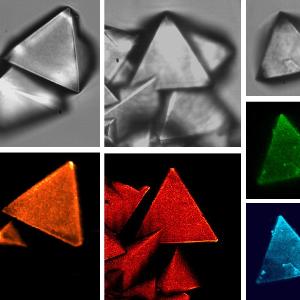Material science: New method probes crystal heterogeneity
26 Nov 2021
A team working with LMU researcher Evelyn Ploetz reports in Advanced Materials.
26 Nov 2021
A team working with LMU researcher Evelyn Ploetz reports in Advanced Materials.

MOSAIC analyses combine different imaging processes to model the properties of individual crystals. | © The Authors. Advanced Materials published by Wiley-VCH GmbH
In metal-organic frameworks (MOFs), the physical and chemical properties of the individual crystals often vary considerably. This heterogeneity affects the material properties of the MOFs, which are used for gas storage, in semiconductors or to harvest water from the air, for example.
A team working with Dr. Evelyn Ploetz from LMU’s Faculty of Chemistry has developed a new method that makes it possible to quantify crystal heterogeneity and its influence on the material properties of MOFs. Using a multimodal imaging system – a combination of spatially resolved fluorescence, Raman spectroscopy and several optical-confocal imaging processes – individual MOF-based crystals can be examined in a correlative manner. Conclusions can then be drawn about how the properties of individual crystals alter the overall properties of the material.
Referred to as multimodal optical spectroscopy and in situ imaging correlation (or MOSAIC) analysis, the method harnesses high spatial resolution and a combination of multiple measuring methods to more accurately characterize how heterogeneity affects material properties. The researchers were, for instance, able to demonstrate that shape has a tremendous influence on the absorption of light by MOF nanocrystals. They also discovered why MOF-801, one of the most promising materials for harvesting water from humid air, does not absorb water evenly.
Adrian Fuchs, Petra Mannhardt, Patrick Hirschle, Haoze Wang, Irina Zaytseva, Zhe Ji, Omar Yaghi, Stefan Wuttke, and Evelyn Ploetz. Single Crystals Heterogeneity Impacts the Intrinsic and Extrinsic Properties of Metal–Organic Frameworks. Advanced Materials